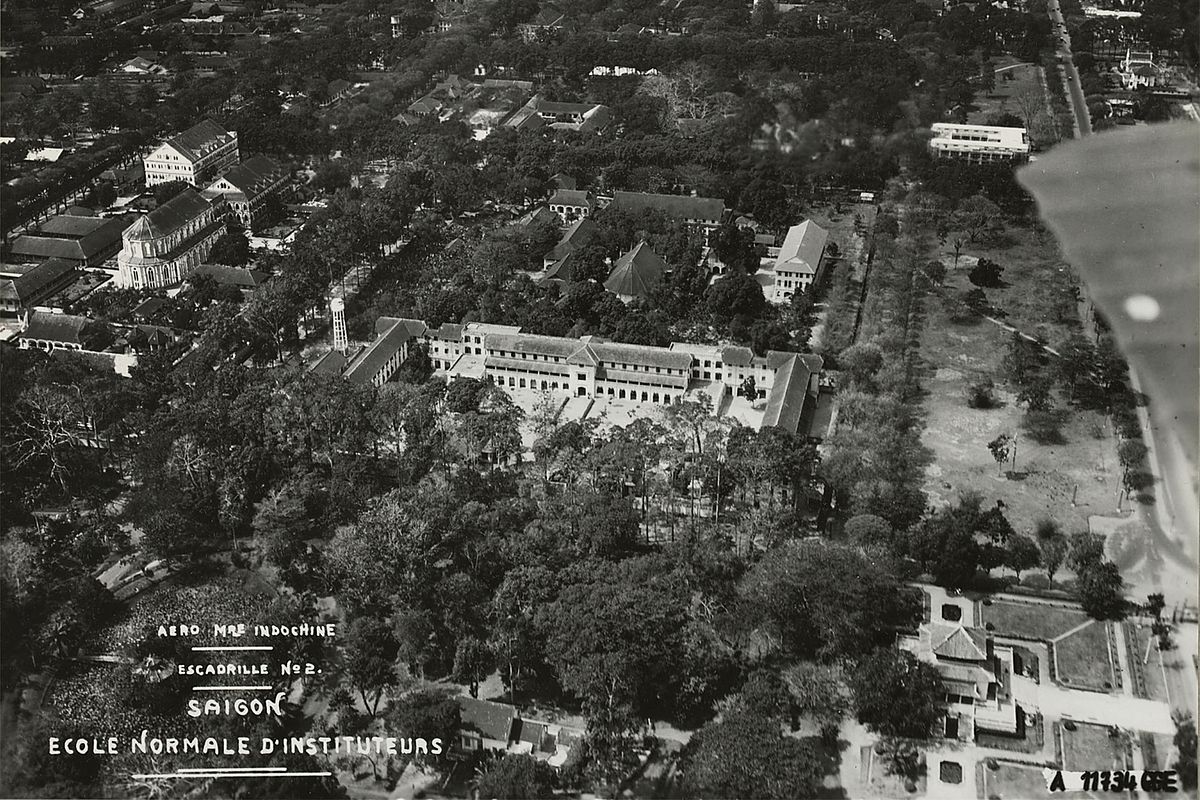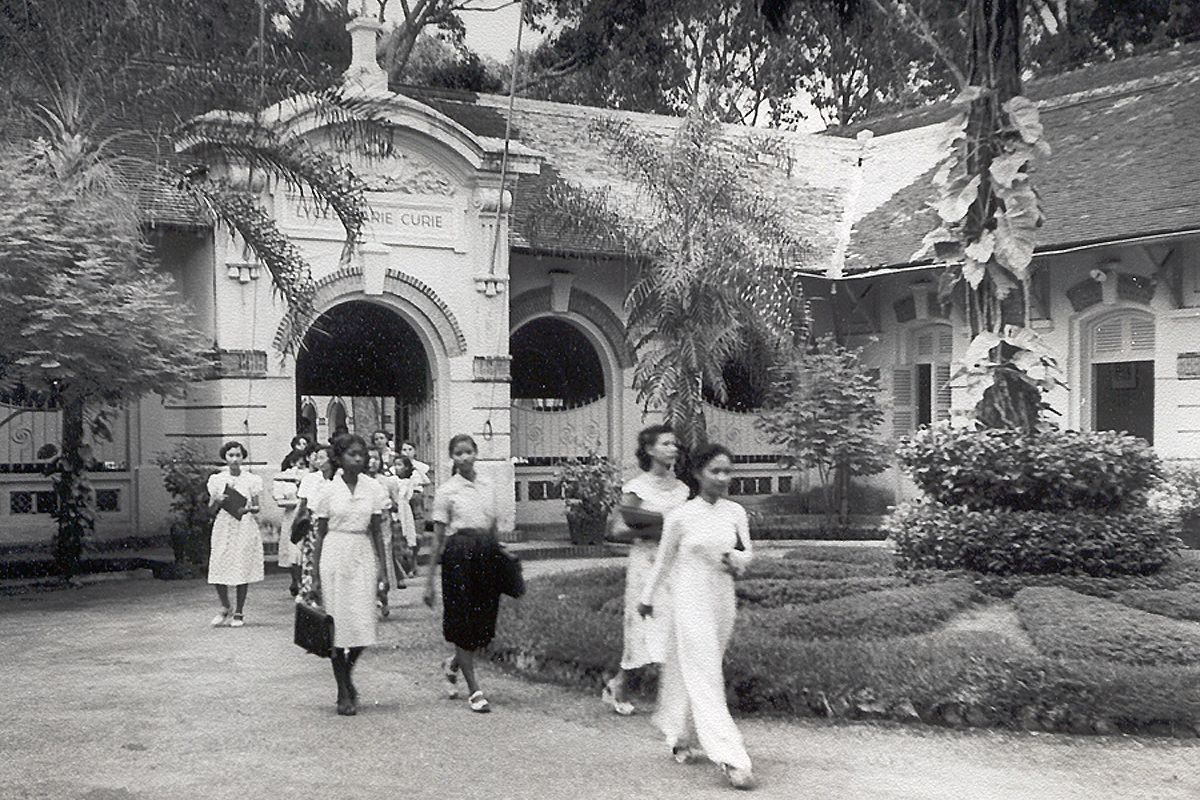Driving past the Saigon Zoological and Botanical Garden toward Nguyễn Hữu Cảnh Street, many of us might not notice the presence of Võ Trường Toản Secondary School and Trưng Vương High School. The two institutions once belonged to one single entity, Collège d’Adran, which many historical sources deem the oldest school in Saigon.

Rue Rousseau (now Nguyễn Bỉnh Khiêm) with the Saigon Zoo on the right (1920s).
Collège d’Adran in Saigon was founded based on a decision signed in 1861 by Admiral Léonard Charner. The campus was constructed on a site on Tây Ninh Street, which was later renamed once to Armand Rousseau Street and then another time to Dr. Angier Street. It's contemporarily known as Nguyễn Bỉnh Khiêm Street. It was a private school founded by the priests of the Society of Foreign Missions of Paris, known in Vietnamese as Hội Thừa sai, an organization of secular priests and lay persons that conduct missionary work overseas.
Collège d’Adran is named after the position of Bishop Bá Đa Lộc, a French Catholic missionary whose real name is Pigneau de Behaine, titular Bishop of Adran (évêque d’Adran). According to historical records, the bishop played an instrumental role in composing a Vietnamese dictionary called Dictionarium Anamitico Latinum in 1773, written in Quốc Ngữ and Nôm scripts. He also contributed financial and human resources to help Emperor Nguyễn Ánh develop Gia Định and other citadels in the country in the 1780s. This evidence suggested that the school might have been named to memorialize the bishop’s contributions.

The school's location on old maps.
In 1866, the school was handed over to the Lasallian Brothers, or the Institute of the brothers of the Christian schools, the first Romanians that came to Indochina to educate impoverished children. They decided to expand Collège d’Adran to more branches in Chợ Lớn, Mỹ Tho, Vĩnh Long in 1867, and Sóc Trăng in 1869.
Collège d’Adran was formally a high school that bestowed Thành Chung degrees after 3–4 years. During its more than 20 years of operation, Collège d’Adran was the pioneer in teaching Quốc Ngữ instead of the traditional Chinese character scripts; French was taught as a foreign language.

The site in 1922 when it housed the École Normale d’Instituteurs, a teaching school.
The Society of Missionaries initially funded all school expenses. The French colonial government later financed and provided scholarships for the school. However, after more than 20 years of operation, the colonial government decided to stop supporting it. Collège d’Adran was closed in 1887, marking the end of government funding for Latin schools in Vietnam. When the school closed, all students transferred to a newly renovated Institution Taberd, now known as Trần Đại Nghĩa High School for the Gifted.

The gate of the teaching institution in the 1920s.
In 1910, part of the old d’Adran campus became Des filles Francaises (Institution municipale de filles à Saigon), a French school for girls while a portion of the campus housed Collège des Interprètes, a school specializing in training interpreters for France.

The building and yard of École Normale d’Instituteurs.
In 1922, the institution changed to the École Normale d’Instituteurs (Practical Pedagogy) to train primary and secondary school teachers. The school was then the only place in the whole of Cochinchina that trained teachers and educators and was later known as Nam Việt Pedagogical School.

During a PE lesson.
After another 20 years of operation, in 1942, the École Normale d’Instituteurs regained its original name, Collège d’Adran. The school then underwent several waves of remodeling that resulted in the contemporary presence of the two previously mentioned schools known today. According to historical records, in 1947, the building was separated to become the Coste military hospital of the French army. Part of the building was still the Nam Việt Pedagogical School.


Left: A cohort photo of 14 classes. Right: Students practice during a carpentry workshop.
By 1954, Võ Trường Toản Secondary School was established in the old facilities of the old Nam Việt Pedagogical School. After ten years as a medical facility, the Coste military hospital moved to Hùng Vương Street, and the land containing d’Adran was reverted to an educational facility, and divided into three parts: the row of houses that used to be the military hospital became Trưng Vương High School for girls. The middle part was the Office of the General Director of High School (later the Department of Examinations). The row of houses to the right that used to be the former Nam Việt Pedagogical school became the Võ Trường Toản High School for boys.

A colorized image showing the campus. The row of houses on the left that used to be the military hospital became Trưng Vương High School for girls. The middle part was the Office of the General Director of High School (later the Department of Examinations). The row of houses to the right that used to be the former Nam Việt Pedagogical school became the Võ Trường Toản High School for boys.
Some famous alumni of College d’Adran Saigon include the first Vietnamese Catholic Bishop, Bishop Nguyễn Bá Tòng, and Trần Chánh Chiếu, or Gilbert Chiếu, a writer, journalist, and revolutionary reformer of the old Cochinchina.
[Photos via Flickr user manhhai]















